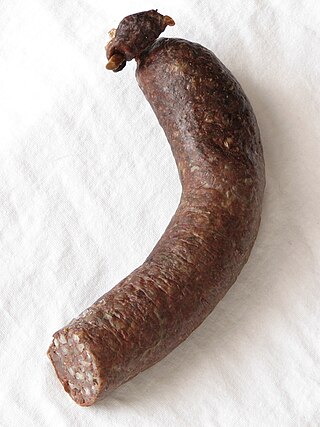Top Qs
Timeline
Chat
Perspective
Kaszanka
Traditional blood sausage in East and Central European cuisine From Wikipedia, the free encyclopedia
Remove ads
Kaszanka is a traditional blood sausage in Central and Eastern European cuisine. It is made of a mixture of pig's blood, pork offal (commonly liver), and buckwheat (kasha) or barley stuffed in a pig intestine. It is usually flavored with onion, black pepper, and marjoram.
This article needs additional citations for verification. (December 2018) |
The dish likely originated in Germany or Denmark.[1]
Kaszanka may be eaten cold, but traditionally it is either grilled or fried with onions and then served with potato and sauerkraut.
Remove ads
Other names and similar dishes
This section needs additional citations for verification. (December 2023) |
- крывянка (Kryvianka, Belarus)
- verivorst (Estonia)
- kaszanka (Poland)
- Kiszka (Yiddish קישקע kishke, some districts of Poland)
- Grützwurst (Germany and sometimes Silesia)
- Knipp (Lower Saxony, Germany)
- Göttwust; Grüttwust (Northern Germany)
- krupńok; krupniok (more of a slight name difference than variation; Silesia)
- żymlok (a variation of Krupniok based on cut bread roll instead of buckwheat; Silesia)
- Pinkel (Northwest Germany)
- Stippgrütze (Westphalia, Germany)
- Westfälische Rinderwurst (Westphalia, Germany)
- krëpnica (Kashubia)
- Maischel (Carinthia, Austria): Grützwurst without blood and not cased in intestine but worked into balls in caul fat. The name comes from the Slovenian majželj, in turn derived from the Bavarian Maisen ("slices").[2]
- jelito (Czechia)
- krvavnička (Slovakia)
- hurka (Slovakia)
- véres hurka (Hungarian)
- кров'янка (krovyanka, Ukraine)
- krvavica (Serbia; Slovenia)
- кървавица (Bulgaria)
- chișcă (Romania)
Remove ads
See also
References
External links
Wikiwand - on
Seamless Wikipedia browsing. On steroids.
Remove ads

